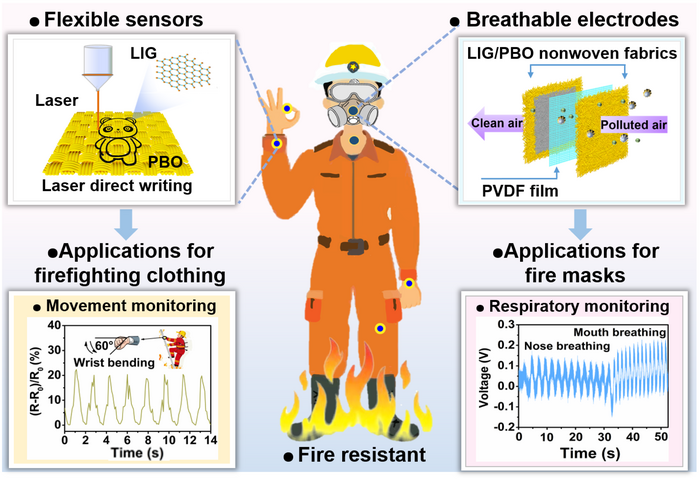Firefighting may appear very different in the future, due to intelligent fire suits and masks created by numerous research institutions in China.

Scientists from multiple institutions address the challenges and limitations of current fire-fighting gear by introducing wearable, breathable sensors and electrodes to better serve firefighters. Image Credit: Nano Research, Tsinghua University Press.
Scientists published findings demonstrating that breathable electrodes woven into fabric used in fire suits are stable at temperatures beyond 520 ºC. The fabric is generally non-combustible at these temperatures, with high rates of thermal protection at the maximum time documented so far for such technology: 18.91 seconds.
The research was published in the journal Nano Research on January 12th, 2023.
The findings demonstrate the effectiveness and practicality of Janus graphene/poly(p-phenylene benzobisoxazole), or PBO, woven fabric in making firefighting “smarter,” with the primary objective being to make products on an industrial scale that are not only flame-retardant but also intelligent enough to alert the firefighter of higher risks while traversing the flames.
Conventional firefighting clothing and fire masks can ensure firemen’s safety to a certain extent. However, the fire scene often changes quickly, sometimes making firefighters trapped in the fire for failing to judge the risks in time. At this situation, firefighters also need to be rescued.
Wei Fan, Professor and Researcher, School of Textile Science and Engineering, Xi’an Polytechnic University
The utilization of Janus graphene/PBO woven fabrics is vital. While not the first of its kind, the use of PBO fibers provides more strength and fire resistance than other related fibers like Kevlar. PBO fibers are woven into a fabric before being irradiated with a CO2 infrared laser. The fabric is then transformed into the Janus graphene/PBO hybrid which is the focus of the research.
The mask also has a Janus graphene/PBO top and bottom layer with a piezoelectric layer in between that converts mechanical pressures to electricity and vice versa.
The mask has a good smoke particle filtration effect, and the filtration efficiency of PM2.5 and PM3.0 reaches 95% and 100%, respectively. Meanwhile, the mask has good wearing comfort as its respiratory resistance (46.8 Pa) is lower than 49 Pa of commercial masks. Besides, the mask is sensitive to the speed and intensity of human breathing, which can dynamically monitor the health of the firemen.
Wei Fan, Professor and Researcher, School of Textile Science and Engineering, Xi’an Polytechnic University
Flame-retardant electronics used in these fire suits are flexible, heat resistant, easy to manufacture, and low-cost, making scaling for industrial production a feasible accomplishment. This increases the likelihood that future firefighting suits and masks will be able to employ this technology efficiently. Rapid, effective interventions can also help to prevent economic losses caused by fires.
The graphene/PBO woven fabrics-based sensors exhibit good repeatability and stability in human motion monitoring and NO2 gas detection, the main toxic gas in fires, which can be applied to firefighting suits to help firefighters effectively avoiding danger.
Wei Fan, Professor and Researcher, School of Textile Science and Engineering, Xi’an Polytechnic University
The ability to detect sudden surges in NO2 gas can enable firefighters to switch course in an instant if necessary, and it could be a lifesaving addition to firefighter gear.
Using graphene/PBO woven and nonwoven fabrics, significant advancements in firefighting can be accomplished to better protect firefighters. The widespread application of this technology may aid researchers in their ultimate goal of minimizing death and injuries among people who risk their lives combating flames.
Yu Luo and Wei Fan contributed equally to the research along with Yaping Miao, Weichun Chen, and Yao Zhang of the School of Textile Science and Engineering at Xi’an Polytechnic University, Huiming Wang of the Department of Chemistry at Tsinghua University, Kai Dong of the Beijing Institute of Nanoenergy and Nanosystems at the Chinese Academy of Sciences, and Lin Hou and Yanyan Xu of Shaanxi Textile Research Institute Co., LTD.
This research was funded by the National Natural Science Foundation of China, Textile Vision Basic Research Program of China, Key Research and Development Program of Xianyang Science and Technology Bureau, Key Research and Development Program of Shaanxi Province, Natural Science Foundation of Shaanxi Province, and Scientific Research Project of Shaanxi Provincial Education Department.
Journal Reference
Luo, Y., et al. (2023) Laser-induced Janus graphene/poly(p-phenylene benzobisoxazole) fabrics with intrinsic flame retardancy as flexible sensors and breathable electrodes for fire-fighting field. Nano Research. doi.org/10.1007/s12274-023-5382-y.